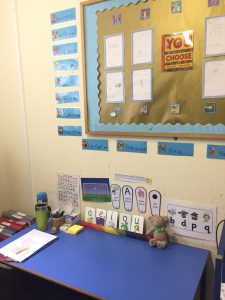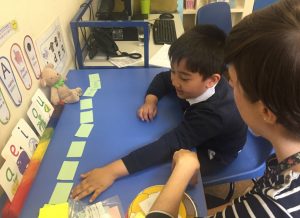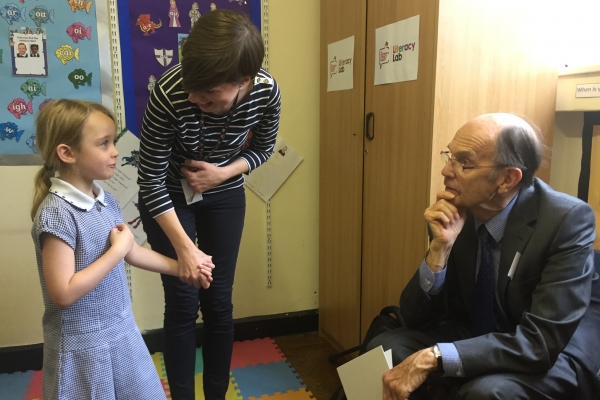“My reading experience started in the war years when we took refuge in the air raid shelter,” explains Sir Jim Rose. “My mother and aunt used to read stories to me by candlelight to keep things calm. I had a great diet of traditional stories stretching from Goldilocks, The Gingerbread Man and Jack and the Beanstalk, to just about all of Hans Christian Andersen. I also learnt to write letters on the wall with the burnt end of a candle. It was very exciting.”
In the world of children’s literacy, Sir Jim Rose scarcely needs an introduction. It was his review of early reading (published in 2006) that led to the wide-scale teaching of phonics in primary schools across the UK. A supporter of The Children’s Literacy charity, Sir Jim’s reflections on his own reading journey have been prompted by a visit to our Literacy Lab at St Matthew’s Primary School in Westminster. Here, children identified as struggling with literacy have been benefiting from our one-to-one phonics-based intervention.

One such child is five-year-old Abigail. On the morning of Jim’s visit, Abigail is confidently reading aloud. Her tutor Jane sits reassuringly beside her and two cuddly friends (Cat and Dog) are perched on the table. Abigail barely hesitates as she reads, pausing only to answer Jane’s questions about the story.
Abigail joined the school in September 2017 and joined the Literacy Lab in January 2018, as soon as a space became available. Since she began attending the Literacy Lab, Abigail has made some astonishing progress. “When Abigail first came to the Literacy Lab she didn’t know all of her letters or sounds,” explains Jane. “She’d just moved to London and was going through a difficult time at home.”
For Abigail, working one-to-one with the same adult in the quiet environment has made an enormous difference. “The bond that you can develop with a child by working in this way is very special – it helps them to grow in confidence and is a safe place from which they can develop,” says Jane.
With many of the school’s children coming from households where there are low levels of literacy, the school begins its formal phonics teaching programme early, identifying children who are struggling swiftly and referring them to our Literacy Lab when they are in Year 1 (ideally at the start).
In recent months, Abigail and Jane have been working through a structured programme, focusing on different phonics sounds. Today’s cuddly props have been carefully chosen to reinforce the sound ‘aw’. Taking a multisensory approach, as part of the session Jane encourages Abigail to reach out and touch the cat’s ‘paw’ and its ‘claw’, saying the words as she does so. Abigail then comes up with her own sentence, “The cat’s paw was sore.”
And Abigail has now reached the stage where – most excitingly of all – she can read stories for herself. Recently, she received a book in assembly as a prize for excellent behaviour which she loves to read. She also has a big book of fairytales which she reads every night before bed.
“Stories present such a rich seam of possibilities,” says Sir Jim. “I seem to recall feeling quite miffed when the ‘all clear’ sounded to leave the shelter in the middle of a story. Once I learnt to read for myself, I enjoyed reading all those traditional tales again. I seem to recall my earliest solo triumphs were Bambi and The Wizard of Oz, then anything to do with animals. It’s so important for children to be immersed in stories from an early age. They help them to make sense of the world.”
Thanks to her hard work and with the help of Jane in our Literacy Lab, Abigail now has a whole world of stories, and possibilities, open to her.
By making a donation to The Children’s Literacy Charity, you could help make this a reality for many more children like Abigail.


